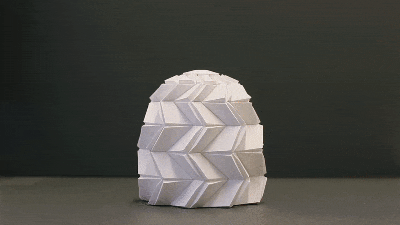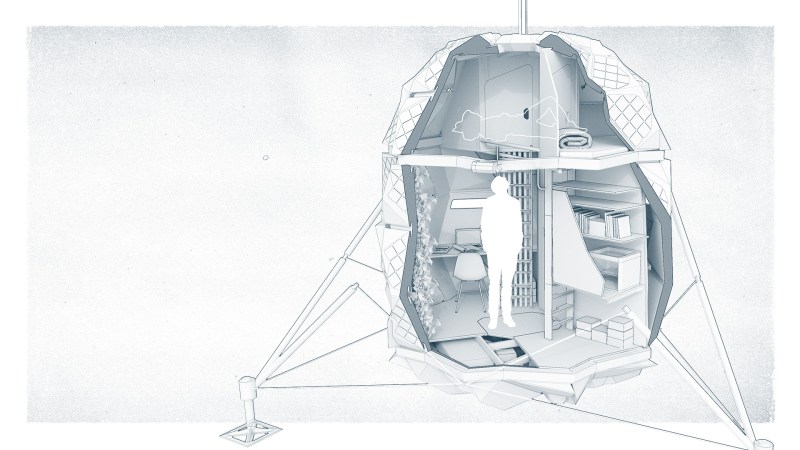[Sebastian and Karl-Johan] are two award-winning Danish Space Architects who are subjecting themselves to harsh, seemingly uninhabitable conditions, for science. The pair set out to build a lunar base that could land with the manned Moon missions in 2024. Like any good engineering problem, what good is a solution without testing? So the pair have placed their habitat in a Moon Analogue habitat and are staying in their habitat for two months. They want to really feel the remoteness, the bitter cold, and the fatigue of actually being on the moon. So far they are about halfway through their journey and expect to return home in December 2020.
When asking themselves where on Earth is it most like the Moon, they came up with Moriusaq, Greenland. It’s cold, remote, in constant sunlight this time of year, and it is a vast white monochrome landscape just like the moon. The first moon settlement missions are expected to be at the South Pole of the Moon, as known as the Peak of Eternal Light.
 The habitat itself is a testament to the duo’s ingenuity. The whole structure folds to fit the tight space and weight requirements of rockets. Taking 2.9m3 (102 ft3) when stored, it expands 560% in volume to 17.2m3 (607 ft3). In Greenland, the structure needs to withstand -30ºC (-22ºF) and 90 km/h winds.
The habitat itself is a testament to the duo’s ingenuity. The whole structure folds to fit the tight space and weight requirements of rockets. Taking 2.9m3 (102 ft3) when stored, it expands 560% in volume to 17.2m3 (607 ft3). In Greenland, the structure needs to withstand -30ºC (-22ºF) and 90 km/h winds.
Because the South Pole is in constant sunlight, the temperature varies much less there than on the rest of the Moon, which makes Greenland a very good analogue temperature-wise. The foldable skin is covered in solar panels, both on the top of the bottom. The highly reflective nature of the Moon’s surface makes it easy to capture the light bouncing up onto the bottom of the habitat.
Several other bits of technology have been included onboard, like a 3D printer, a circadian light stimulation system, an algae reactor, and a weather simulation. Since both the Moon and Greenland are in constant sunlight, the pod helps regulate the circadian rhythms of the occupants by changing the hue and brightness throughout the day. The weather simulation tries to break up the monotony of space by introducing weather like a stormy day or rainbow colours.
Their expedition is still ongoing and they post daily mission updates. While some might call their foray into the unknown madness, we call it bold. Currently, NASA is planning its Artemis mission in 2024 and we hope that the lessons learning from the Lunark and other experiments culminate in a better experience for all astronauts.
















You mentioned twice in this article that Greenland has constant sunlight, but Greenland is currently experiencing near constant darkness.
I love the concept of this compressible structure, and I’m glad people are testing it now. I do wonder how well it would deal with the pressure differential though. I assume that’s being tested somehow as well.
I was wondering the same thing. My friend lives in Alaska and they are nearing the period where he won’t see the sun for multiple days. I think the author got their poles mixed up. Curious if the moons poles were mixed up as well but I assume constant sunlight is what the mission would want because no sun is cold.
I live on the 64th paralell and was thinking the same thing….
The writer also mentions “he first moon settlement missions are expected to be at the South Pole of the Moon”. The south pole of the /Earth/ is now in permanent sunlight, so maybe this got the writer mixed up.
> The highly reflective nature of the Moon’s surface…
Various webpages claim the albedo of the Moon is 0.12 to 0.14.
Get the moon some viagra already
Yea I found that sentence a bit odd as well, as I’ve read the moon having the same reflective properties as asphalt (tarmac for the US people).
Also it’s going towards winter now in Greenland meaning cold and little to no sunlight, and in the sommer it can get rather warm.
I hope for the guys who plan to live in that for 2 months, that the factual inconsistencies aren’t from them but rather somewhere on the way to this article.
They have been in the area since the 3rd of September.
First day of the simulation seems to be the 2nd of October, so they have less than a month left.
Side tangent: As a US resident, everyone I know calls the material from which roads and parking lots are constructed “asphalt”. In my experience, “tarmac” is only used colloquially, usually in reference specifically to an airport runway.
Similar here in New Hampshire.
Side note: In my younger years I had a small sports car (a Subaru XT-6 for those who are curious) that was a nice shade of metallic silver. I ended up rewiring the fog lights to be on at all times because in sunlight my car blended in with sun-bleached asphalt PERFECTLY. I also ended up installing air horns.
I tended toward vehicles with darker colors after that.
Fair enough.
I can only remember hearing the latter used by Americans, and the former being used for bitumen, though that could have been some outlier getting stuck in my head.
In the UK we refer to “asphalt” as “tarmac”, but we also understand “asphalt”.
To paraphrase a saying i saw on a driveway companies truck, ” ”’if your
tarmac isn’t , it’s your own asphalt” … I’ll let myself out —–>
At one point the South Pole is mentioned in the article yet this experiment is taking place in greenland… So what’s up with that?
They are referring to the South Pole of the Moon, at that point, I believe.
That would be the south pole of the moon i guess.
Another interesting space exploration simulation program: https://www.sensoria.space/
“They want to really feel the remoteness, the bitter cold…”
Do astronauts experience bitter cold? Or do their suites and habitats keep them at a completely comfortable temperature?
I may be wrong but it’s my understanding that the problem in space and on the moon was getting rid of excess body heat. No air = no significant convection nor conduction.
You are both right and wrong – with no external atmosphere there is nothing damping the thermal swings of being in direct sunlight or in the shadows.
So while in the shadow the dumping of only the waste heat is an issue – its still possible, so as long as the radiative surface is the right size you are sorted. It can actually be harder to stay warm as all the energy to keep the climate conditions correct has to be carried on board.
In the sun however with nothing to disperse the rays or atmosphere to convect surface heat away its really all about managing the heat – so the hot side doesn’t melt, expand thermally into a rupture, cook the occupants etc. Then the only way to radiate the excess heat is to conduct much of it to your own shadow (made a mini dark side) and radiate it along with any excess at a sufficient rate to not cook (or at least not to cook too fast).
I am confused…. How are hurricane force winds being used to prep for a moon habitat?
Moon storms. Happen all the time. Just ask anyone serving the Space Navy.
The south pole of the Moon is in some areas in constant year round sunlight. Right next door to your origami egg is a crater with real ice in it. The solar panels both on the top of the bottom (oops) will get equal amounts of light as the sun takes a month to go around at it’s always low angle elevation. So the sides will get to be switched over every day or so as the sun moves around like on one of earth’s poles, only all the time. You will want to land on a high spot. There is some really old ice in those craters, science!
No mention of how bad living on the surface of the moon is for humans ?
https://science.nasa.gov/science-news/science-at-nasa/2005/08sep_radioactivemoon
It’d be better off replacing the dome of doom with some digging equipment or using it as an airlock to get into the tunnels. Even w/o a solar flare to ruin the show, 2 months of unshielded exposure could get interesting.
It says so much about humans that we’d send people to THE MOON and worry about them getting bored of the view.
“The highly reflective nature of the Moon’s surface makes it easy to capture the light bouncing up onto the bottom of the habitat.”
Surely it won’t stay very reflective after people are walking around on it.